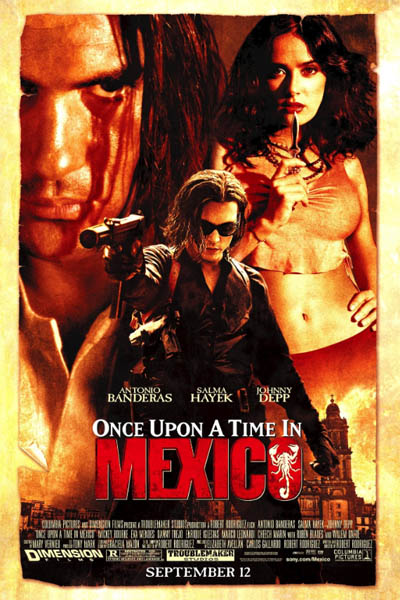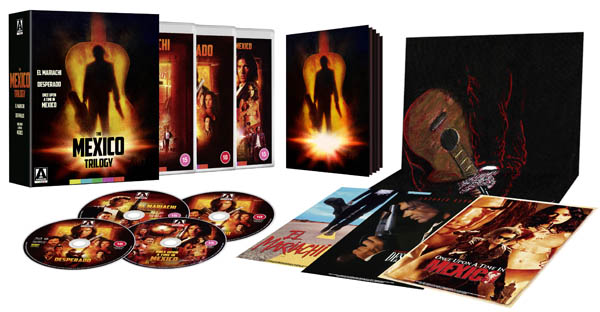Once Upon A Time In Mexico (2003)
Directed by: Robert Rodriguez
Written by: Robert Rodriguez
Starring: Antonio Banderas, Cheech Marin, Danny Trejo, Eva Mendes, Johnny Depp, Marco Leonardi, Mickey Rourke, Rubén Blades, Salma Hayek, Tito Larriva, Willem Dafoe

ONCE UPON A TIME IN MEXICO (2003)
Written and Directed by Robert Rodriguez
Available on Arrow Video Limited Edition 4K UHD and Blu-Ray
When a plot is discovered by the CIA that the Barillo cartel plans to kill the president in a coup d’etat organised with military General, Marquez, our unnamed, gun-toting Mariachi is brought out of retirement in order to prevent Marquez from taking control but El Mariachi has his own reasons for taking on the job.
The final film in Robert Rodriguez’s Mexico trilogy, shot six years after the release of Desperado, sees the mythical guitarist dusting off his guitar case one more time in an act of retribution. But this isn’t just El Mariachi’s story. The threat in ONCE UPON A TIME IN MEXICO could see all of Mexico under the rule of the devious and deadly drug gangs.
Ramping up the action with high speed chases and upping the ante by bringing in the power of the military, you’d expect ONCE UPON A TIME IN MEXICO to catapult its mariachi character to legendary status, but the film fails to give the trilogy’s star the send off he deserves as he plays second fiddle (or should that be rhythm guitar?) in his own film as a brand new set of characters with their own respective storylines take centre stage, leaving the myth of El Mariachi to brood in the shadows.
If you loved Desperado then I’m afraid you may struggle with this third instalment unless you watch it purely as a standalone action flick. ONCE UPON A TIME IN MEXICO‘s main problem is that the plot is so convoluted that it’s hard to actually focus on any part of it. The inclusion of a vast number of characters, none of whom could be classed as the main character, means the screenplay is spread so thin to include them all that none of them get the actual screen-time or story development they deserve, especially El Mariachi, who is usually the star of the series and is the person whose story we’ve been following since the first film. He actually becomes a backseat player in his own trilogy, and even though there’s some cracking stunts and scenes with him and Carolina (played once again by the smouldering Salma Hayek), they’re not given the prominence they deserve. Their story is basically a flashback, a memory that’s shoe-horned in to try and tie the events and emotional state of the Mariachi together between Desperado and Once Upon A Time In Mexico.
As I mentioned, there’s so many characters played by big name actors in ONCE UPON A TIME IN MEXICO that most of them are drowning and lost in the story. As the film flits from one plot thread to another, with Depp’s CIA agent Sheldon Jeffrey Sands tying them all together as he sets them up like dominoes, we hardly spend any time with them which means we hardly care or invest in their characters, no matter if they’re a bad guy or a good guy. For instance, there’s scenes with Ruben Blades’ retired FBI agent Jorge Ramirez who tries to take down Armando Barillo (Willem Dafoe) through wanted fugitive Billy Chambers, played by Mickey Rourke, who’s Barillo’s lead henchman. Rourke’s character serves very little purpose that if Billy was cut from the film it wouldn’t make much difference. As for Barillo himself, as the big boss of the cartel and the man behind the attempted coup d’etat, you’d expect that the film would get more involved with him but it doesn’t. Time spent with villains Moco and Bucho in earlier films put this film to shame and even they didn’t get a ton of airtime in their own respective films, but was enough to effectively show the power these guys had. They seem to paint so many characters as some kind of antagonist in ONCE UPON A TIME IN MEXICO you don’t know where to look and who to trust: Cucuy, Marquez, Barillo – all malevolent people. Even Sands is dubious in his intentions as he appears to play sides against each other for his own gain, even putting El Mariachi’s life at risk after hiring him to prevent Mexico falling to Marquez. It all seems so convoluted yet shallow that, unlike Desperado whose storyline I was totally absorbed by, this movie failed to make me give a damn about anyone… even El, which is a crying shame.
Another bugbear of mine with the movie, which only adds to the confusion I’ve already mentioned, is the editing. At the beginning of the movie, it says “chopped” by Rodriguez and unfortunately that seems like the perfect description of what we have before us. The number of cuts in ONCE UPON A TIME IN MEXICO seems rather excessive to the point it’s hard to tell what’s going on. It feels like I’m watching a TikTok video for kids who haven’t the attention span to watch any scene for longer than 10 seconds. The choppy nature, flitting from one thing to another, makes it difficult to put a time and place to the scene playing out to the point that I was unable to appreciate the storyline of the scene as a whole. It’s as if someone just cut a load of clips together and went “voila! film”. This is so disappointing as Rodriguez’s style of filmmaking is what attracted me to these movies in the first place, but this instalment feels as though it’s deviated somewhat. There are flashes of the old filmmaker there, mainly the scenes involving Banderas – with a particular favourite of mine being the segment where El Mariachi finds himself and Carolina chained together. There’s even a few inspired camera angles that look great, in addition to nods to the previous two movies, such as a gunman being catapulted into the air after being shot, the supporting character appearance of a young boy in a yellow t-shirt and El Mariachi, accompanied this time by Carolina, flying onto the hood of an oncoming bus, just like we saw in El Mariachi.
It’s a pity the third film hasn’t continued in the path of its predecessors, both in style and substance. Whilst there’s always been humour to the series, ONCE UPON A TIME IN MEXICO almost feels like an entire joke due to the lack of meaningful plot. As much as I’m a fan of Johnny Depp, his CIA agent role feels as though he’s constantly taking the piss, from constantly raving about his Puerco Pibil meal to anyone who’ll listen, to his daft disguises. It feels like an attempt at doing a Tarantino by having some crazy dialogue play out but it doesn’t hit quite the mark like Tarantino’s efforts do. Then we have El’s mariachi pals, one of whom is an alcoholic, who play in a bar and offer favours depending on how much people are willing to stump up (different rates for a song, a kiss or to sleep with a mariachi) – a bit like a gentleman’s club, except aimed at women punters. This feels like a nod to the seedy atmosphere at the Titty Twister in From Dusk Til Dawn. The humour, for the most part, doesn’t hit quite as well as the other films, except for during flashbacks (again, my favourite bits), such as when El Mariachi discovers he’s shackled to Carolina. That flashback has the chemistry, humour and magic reminiscent of Desperado. Everything else feels underdeveloped and pales in comparison.
Having Cheech Marin, Tito Larriva and Danny Trejo return as different characters in ONCE UPON A TIME IN MEXICO is a nice touch, whilst the sounds of Patricia Vonne’s Traeme Paz and Juno Reactor’s Pistolero adds energy and attitude to the action sequences. Unfortunately, the few things I feel have a positive influence on the film aren’t enough to overcome the shallow story and character development. Even Catalina, such a prominent character in Desperado, becomes a footnote in the saga. There are reasons for this but when there’s a lot of scenes in the movie that feel unnecessary or simply placed to move the plot along, rather than add any real substance to the film, I wish Rodriguez had approached the film in a different fashion.
Switch your brain off, grab a bowl of popcorn and ONCE UPON A TIME IN MEXICO may give you 100 minutes of OTT entertainment. Just don’t expect it to meet the benchmark that was set so high by its predecessors.

Disc 4 of Arrow Video’s limited edition Mexico Trilogy release culminates with Once Upon A Time in Mexico on Blu-Ray featuring the original DTS-HD MA 5.1 surround and 2.0 stereo audio and optional English subtitles for the deaf and hard-of-hearing, amongst a slew of special features.
Audio Commentary by writer-director Robert Rodriguez
Robert Rodriguez talks about the methodology of making Once Upon A Time in Mexico, as well as telling funny stories about the film. Like his commentaries on the previous films in the trilogy, this is well worth a listen to understand the ideas and approach to making the film.
The Revolution Will Be Digitized – a newly filmed interview with Robert Rodriguez (12 mins 41 secs)
In this new interview, Robert Rodriguez shares how Once Upon A Time in Mexico was shot quickly after writing the script in a week and a half after being greenlit. He discusses opting to shoot on digital for the first time and the challenges with working with the new technology as novices, but the benefits it had over film that make it so much better. He also talks about recording the score and how he’d get the actors involved in creating the score for their own characters.
Troublemakin’ – a newly filmed interview with visual effects editor Ethan Maniquis (9 mins 50 secs)
Ethan Maniquis talks about his career in film, and how he got to grips with editing by playing on Lightworks where he worked. He recounts his time working at Miramax before taking control of VFX shots.
Eight deleted scenes – with optional commentary by Robert Rodriguez (7 mins 47 secs)
A series of deleted scenes – some of which add more to the character and the film, others which were just fluff.
Ten Minute Flick School – an archive featurette narrated by Robert Rodriguez (9 mins 5 secs)
In the latest Ten Minute Film School, or Flick School as newly titled, Rodriguez blasts through a range of tricks, which were done whilst shooting or on the computer, to get the desired effect we see on screen. We see what was involved with Carolina’s knife throw and Bellini and Sands’ eyes, in addition to the ability to digitally remove people and objects, such as the crane in the dangling scene between a shackled El Mariachi and Carolina, which allowed the filmmaker to be more adventurous. Rodriguez also details the way bullet hits and flashes could be digitally created later rather than having to rig the walls during the shoot.
Inside Troublemaker Studios – an archive featurette on Robert Rodriguez’s studio in Austin (11 mins 24 secs)
A look inside Rodriguez’s setup. His home garage has been converted into a mix room, editing room, mixing stage and a place to record live music. Rodriguez goes through his setups in each room, with the use of Avid for editing and Pro Tools and Gigastudio for music.
He then shows his tech that allows him to move at the speed of thought, linking up with his remote offices to make changes quickly, before visiting his main stage in Austin.
Ten Minute Cooking School – an archive featurette in which Robert Rodriguez shows you how to cook Puerco Pibil (5 min 50 secs)
It’s featured often enough in the film, so director Robert Rodriguez shows you how to make the Puerco Pibil dish that Agent Sands can’t get enough of.
Film is Dead: An Evening with Robert Rodriguez, a presentation by the director given in 2003 (13 mins 20 secs)
Rodriguez talks about his decision to shoot on HD digital after being shown clips of Attack of the Clones by George Lucas and being impressed with the footage. He talks about how digital transformed the way he created film, and how being able to play it back and see exactly what you were getting gave the crew and performers more confidence in their job. Danny Trejo makes an on-stage appearance too as Rodriguez explains how digital is able to show Danny’s features in all their glory. He follows the talk by holding a brief Q+A.
The Anti-Hero’s Journey – an archive featurette on the arc of the Mariachi (18 mins 5 secs)
Robert Rodriguez, Antonio Banderas, Johnny Depp, Salma Hayek and Willem Dafoe talk about the film and their characters whilst we’re treated to behind-the-scenes footage.
The Good, the Bad and the Bloody: Inside KNB FX, an archive featurette on the film’s special effects (19 mins 4 secs)
Greg Nicotero and Jake Garber talk about working on the movie, accompanied by behind-the-scenes footage of the Bellini dummy used when Sands is dumping the body; the matador dummy that’s thrust into the air by the bull at the bull fight; Sands’ fake third arm, and Barillo’s post-op surgery appearance. They talk about having little preparation, and having to do it most of it whilst they filmed.








Be the first to comment